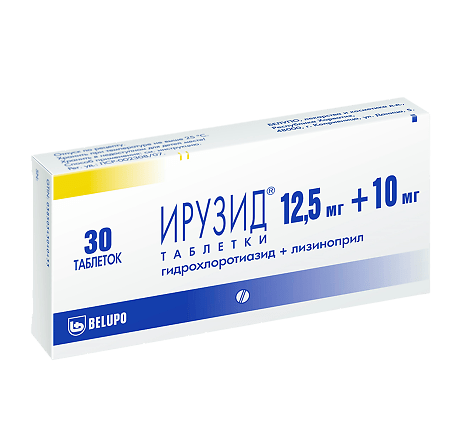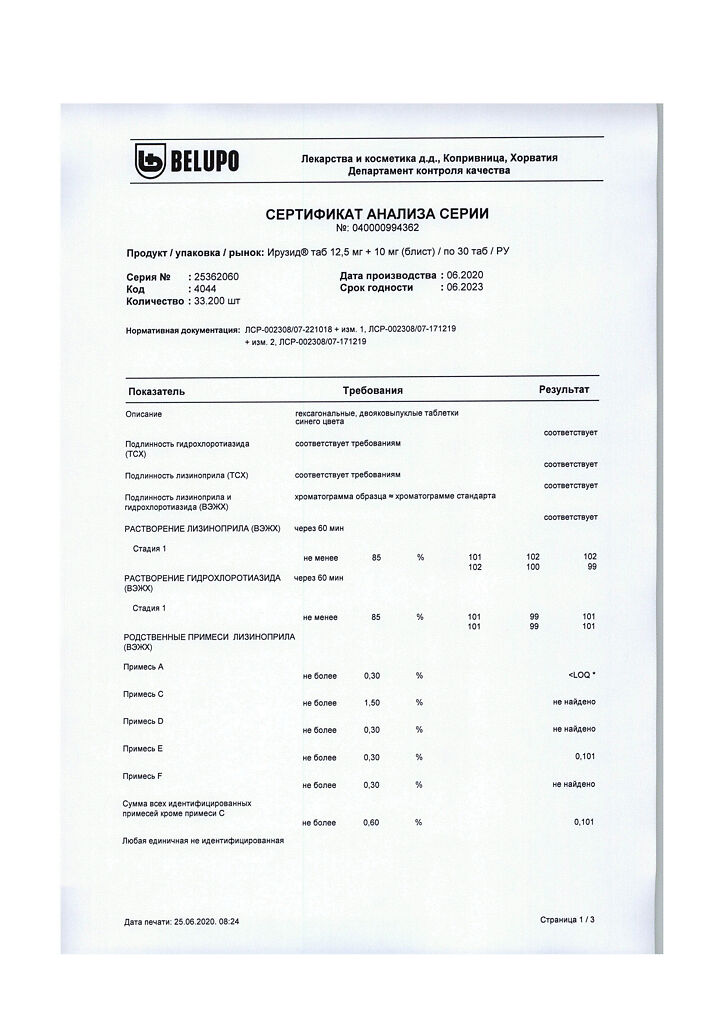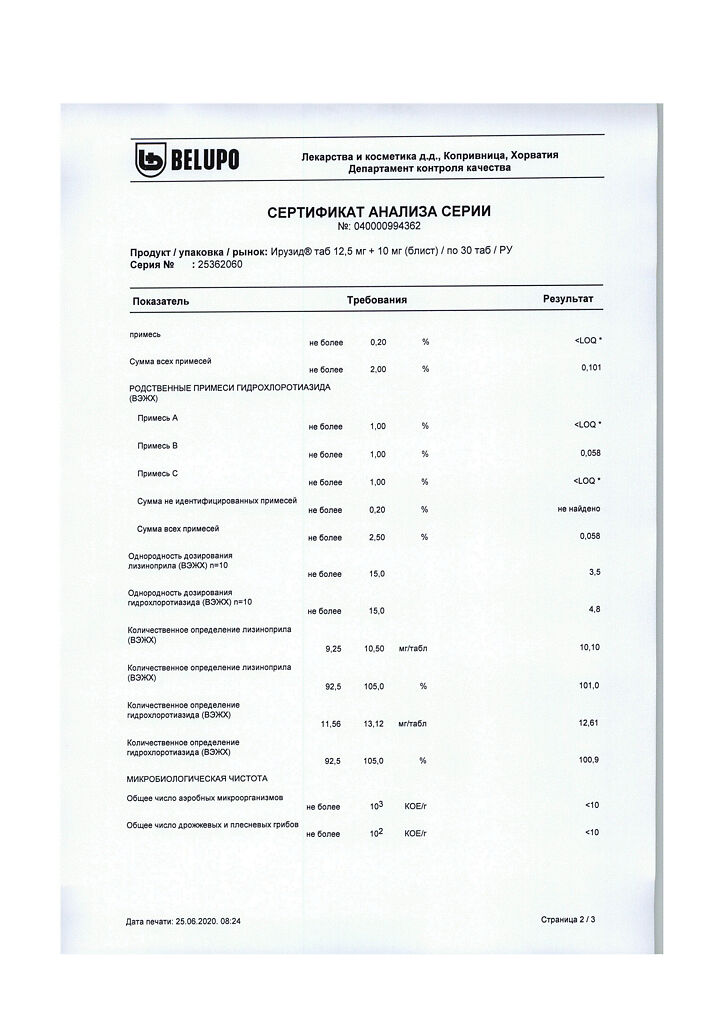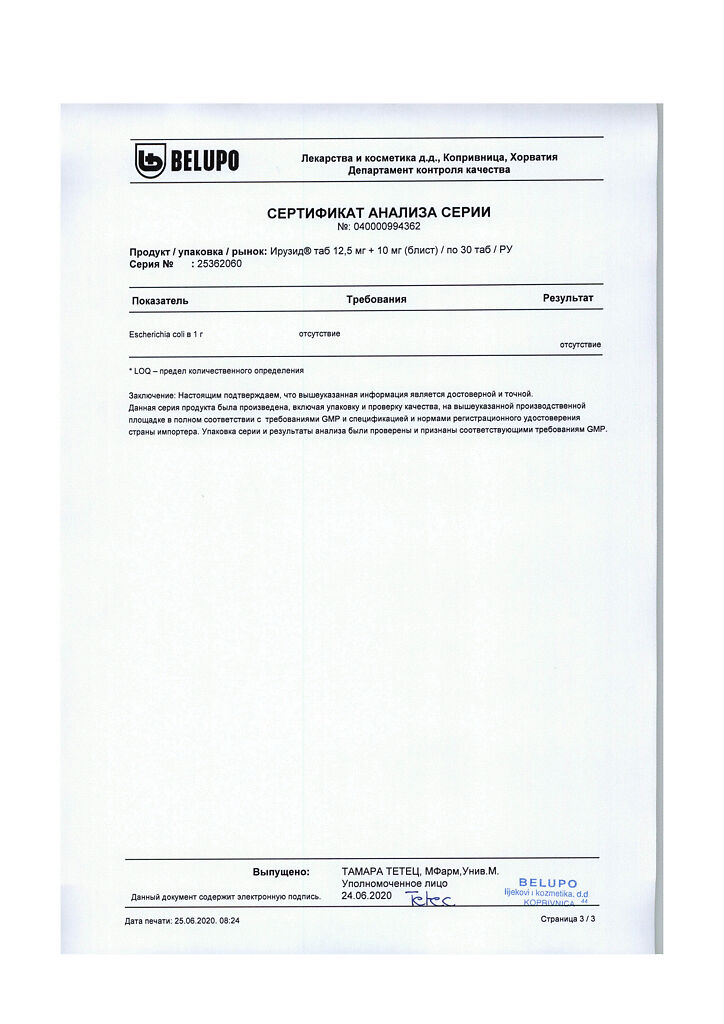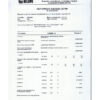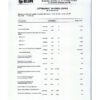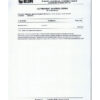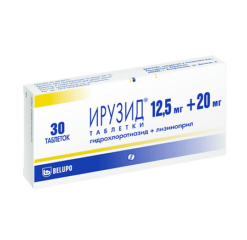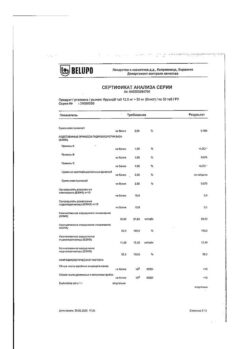No products in the cart.
Iruzid, tablets 10 mg+12, 5 mg, 30 pcs.
€17.25 €14.37
Description
Iruzid is a diuretic, antihypertensive.
Pharmacodynamics
Hypotensive combined agent. It has antihypertensive and diuretic action.
Lisinopril
A ACE inhibitor, reduces the formation of angiotensin II from angiotensin I. Reduction of angiotensin II leads to a direct reduction of aldosterone release. Reduces bradykinin degradation and increases GH synthesis. Reduces OPPS, BP, preload, pulmonary capillary pressure, causes an increase in minute blood volume and increases exercise tolerance in patients with chronic heart failure. Dilates arteries more than veins.
Some effects are explained by the effect on tissue renin-angiotensin systems. Long-term use reduces the severity of myocardial hypertrophy and arterial resistive walls. It improves the blood supply to the ischemic myocardium. ACE inhibitors prolong life expectancy in patients with chronic heart failure, slow the progression of left ventricular dysfunction in patients who have had myocardial infarction without clinical manifestations of heart failure.
The antihypertensive effect begins after approximately 6 hours and lasts for 24 hours. The duration of the effect also depends on the dose. Onset of action is in 1 hour, the maximum effect is determined after 6-7 hours. In case of arterial hypertension, the effect is noted in the first days after the start of treatment, the stable effect develops after 1-2 months.
When the drug is abruptly withdrawn, no pronounced increase in BP is observed.
In addition to lowering BP, lisinopril decreases albuminuria. In patients with hyperglycemia, it helps to normalize the function of the damaged glomerular endothelium.
Lisinopril does not affect blood glucose concentrations in patients with diabetes mellitus and does not lead to increased incidence of hypoglycemia.
Hydrochlorothiazide
Thiazide diuretic whose diuretic effect is associated with disruption of reabsorption of sodium, chloride, potassium, magnesium and water ions in the distal nephron; it delays excretion of calcium and uric acid ions. It has antihypertensive properties; hypotensive effect develops due to dilatation of arterioles. It has practically no effect on normal BP. Diuretic effect occurs after 1-2 hours, reaches a maximum after 4 hours and lasts 6-12 hours.
The antihypertensive effect occurs within 3-4 days, but it may take 3-4 weeks to reach the optimal therapeutic effect.
Lisinopril and hydrochlorothiazide, if used simultaneously, have an additive antihypertensive effect.
Indications
Indications
Arterial hypertension (in patients for whom combination therapy is indicated).
Pharmacological effect
Pharmacological effect
Iruzid – diuretic, antihypertensive.
Pharmacodynamics
Antihypertensive combination drug. Has antihypertensive and diuretic effects.
Lisinopril
An ACE inhibitor, reduces the formation of angiotensin II from angiotensin I. A decrease in the content of angiotensin II leads to a direct decrease in the release of aldosterone. Reduces the degradation of bradykinin and increases the synthesis of PG. Reduces peripheral vascular resistance, blood pressure, preload, pressure in the pulmonary capillaries, causes an increase in minute blood volume and increased exercise tolerance in patients with chronic heart failure. Dilates arteries more than veins.
Some effects are explained by effects on tissue renin-angiotensin systems. With long-term use, the severity of hypertrophy of the myocardium and the walls of resistive arteries decreases. Improves blood supply to ischemic myocardium. ACE inhibitors prolong life expectancy in patients with chronic heart failure and slow the progression of left ventricular dysfunction in patients who have suffered a myocardial infarction without clinical manifestations of heart failure.
The antihypertensive effect begins after approximately 6 hours and lasts for 24 hours. The duration of the effect also depends on the dose. The onset of action is after 1 hour, the maximum effect is determined after 6–7 hours. In arterial hypertension, the effect is observed in the first days after the start of treatment, a stable effect develops after 1–2 months.
When the drug is abruptly discontinued, no pronounced increase in blood pressure is observed.
In addition to lowering blood pressure, lisinopril reduces albuminuria. In patients with hyperglycemia, it helps to normalize the function of damaged glomerular endothelium.
Lisinopril does not affect the concentration of glucose in the blood in patients with diabetes mellitus and does not lead to an increase in cases of hypoglycemia.
Hydrochlorothiazide
A thiazide diuretic, the diuretic effect of which is associated with impaired reabsorption of sodium, chlorine, potassium, magnesium, and water ions in the distal nephron; delays the excretion of calcium ions and uric acid. Has antihypertensive properties; the hypotensive effect develops due to the expansion of arterioles. Has virtually no effect on normal blood pressure. The diuretic effect occurs after 1–2 hours, reaches a maximum after 4 hours and lasts 6–12 hours.
The antihypertensive effect occurs within 3–4 days, but 3–4 weeks may be required to achieve optimal therapeutic effect.
Lisinopril and hydrochlorothiazide, when used simultaneously, have an additive antihypertensive effect.
Special instructions
Special instructions
Symptomatic hypotension
Most often, a pronounced decrease in blood pressure occurs with a decrease in fluid volume caused by diuretic therapy, reducing the amount of salt in food, dialysis, diarrhea or vomiting (see “Interaction” and “Side effects”). In patients with chronic heart failure with or without simultaneous renal failure, a pronounced decrease in blood pressure is possible. Hypotension is more often detected in patients with severe heart failure as a consequence of the use of large doses of diuretics, hyponatremia, or impaired renal function. In such patients, treatment should begin under the strict supervision of a physician. Similar rules must be followed when prescribing to patients with coronary artery disease or cerebrovascular insufficiency, in whom a sharp decrease in blood pressure can lead to myocardial infarction or stroke.
A transient hypotensive reaction is not a contraindication for taking the next dose of the drug.
Before starting treatment, if possible, the sodium concentration should be normalized and/or the lost volume of fluid should be replenished, and the effect of the initial dose of the drug on the patient should be carefully monitored.
Renal dysfunction
In patients with chronic heart failure, a pronounced decrease in blood pressure after initiation of treatment with ACE inhibitors may lead to further deterioration of renal function. Cases of acute renal failure have been reported. In patients with bilateral renal artery stenosis or stenosis of the artery of a solitary kidney who received ACE inhibitors, there was an increase in serum urea and creatinine, usually reversible after discontinuation of treatment. These changes were more common in patients with renal failure.
Hypersensitivity/Angioedema
Angioedema of the face, extremities, lips, tongue, epiglottis and/or larynx may occur at any time during treatment and has rarely been reported in patients treated with ACE inhibitors, including lisinopril. In this case, treatment with lisinopril should be stopped as soon as possible and the patient should be monitored until complete regression of symptoms. In cases where swelling occurs only on the face and lips, it most often goes away without treatment, but antihistamines may be prescribed.
Angioedema with laryngeal edema can be fatal. When the tongue, epiglottis or larynx are involved, airway obstruction may occur, so appropriate therapy (0.3–0.5 ml of epinephrine (adrenaline) solution 1:1000 subcutaneously) and/or measures to ensure airway patency should be immediately administered.
Patients who have a history of angioedema not related to previous treatment with ACE inhibitors may be at increased risk of developing it during treatment with an ACE inhibitor.
Cough
When using an ACE inhibitor, a dry, prolonged cough was observed, which disappeared after stopping treatment with the ACE inhibitor. When making a differential diagnosis of cough, cough caused by the use of an ACE inhibitor must also be taken into account.
Patients on hemodialysis
Anaphylactic reactions have also been observed in patients undergoing hemodialysis using high-permeability dialysis membranes who are also taking ACE inhibitors. In such cases, the use of a different type of dialysis membrane or another antihypertensive drug should be considered.
Surgery/General anesthesia
When using drugs that lower blood pressure in patients undergoing major surgery or during general anesthesia, lisinopril can block the formation of angiotensin II. A pronounced decrease in blood pressure, which is considered a consequence of this mechanism, can be eliminated by increasing the volume of blood volume.
Before surgery (including dental surgery), it is necessary to warn the surgeon/anesthesiologist about the use of ACE inhibitors.
Serum potassium
In some cases, hyperkalemia was observed.
Risk factors for the development of hyperkalemia include renal failure, diabetes mellitus, and taking potassium supplements or drugs that increase potassium levels in the blood (such as heparin), especially in patients with impaired renal function.
In patients at risk of symptomatic hypotension (those on a low-salt or salt-free diet) with or without hyponatremia, as well as in patients who have received high doses of diuretics, fluid and salt losses must be compensated before starting treatment.
Metabolic and endocrine effects
Thiazide diuretics can affect glucose tolerance, so it is necessary to adjust the doses of antidiabetic drugs.
Thiazide diuretics may reduce urinary calcium excretion and cause hypercalcemia. Severe hypercalcemia may be a symptom of latent hyperparathyroidism. It is recommended to discontinue treatment with thiazide diuretics until a test to assess parathyroid function is performed.
During treatment with the drug, regular monitoring of blood plasma potassium, glucose, urea and lipids is necessary.
During the treatment period, it is not recommended to drink alcoholic beverages, because alcohol enhances the hypotensive effect of the drug.
Caution should be exercised when performing physical exercises in hot weather (risk of dehydration and excessive reduction in blood pressure due to a decrease in blood volume).
Impact on the ability to drive a car or perform work that requires increased speed of physical and mental reactions. During the treatment period, you should refrain from driving vehicles and engaging in potentially hazardous activities that require increased concentration and speed of psychomotor reactions, because Dizziness is possible, especially at the beginning of treatment.
Active ingredient
Active ingredient
Hydrochlorothiazide, Lisinopril
Composition
Composition
1 tablet contains:
Active ingredients:
lisinopril,
hydrochlorothiazide;
Excipients:
calcium phosphate dibasic,
mannitol, corn starch,
pregelatinized corn starch,
magnesium stearate,
iron oxide yellow,
purified water.
Pregnancy
Pregnancy
The use of lisinopril during pregnancy is contraindicated. If pregnancy is established, taking Iruzid should be stopped as soon as possible.
Taking inhibitors in the second and third trimester of pregnancy has an adverse effect on the fetus (a marked decrease in blood pressure, renal failure, hyperkalemia, cranial hypoplasia, and intrauterine death are possible).
There is no data on the negative effects of the drug on the fetus when used during the first trimester. It is recommended to monitor newborns and infants who have been exposed to ACE inhibitors in utero for timely detection of a pronounced decrease in blood pressure, oliguria, and hyperkalemia.
During treatment with Iruzid, breastfeeding should be discontinued.
Contraindications
Contraindications
hypersensitivity to the drug, other ACE inhibitors and sulfonamide derivatives;
anuria;
severe renal failure (creatinine Cl < 30 ml/min);
angioedema (including a history of use of ACE inhibitors);
hemodialysis using high-flow membranes;
hypercalcemia;
hyponatremia;
porphyria;
precoma;
hepatic coma;
severe forms of diabetes mellitus;
age under 18 years (efficacy and safety have not been established).
With caution: aortic stenosis/hypertrophic cardiomyopathy; bilateral renal artery stenosis; stenosis of the artery of a single kidney with progressive azotemia; condition after kidney transplantation; renal failure (Cl creatinine >30 ml/min); primary hyperaldosteronism; arterial hypotension; bone marrow hypoplasia; hyponatremia (increased risk of developing arterial hypotension in patients on a low-salt or salt-free diet); hypovolemic conditions (including diarrhea, vomiting); connective tissue diseases (systemic lupus erythematosus, scleroderma); diabetes mellitus; gout, hyperuricemia; inhibition of bone marrow hematopoiesis; hyperkalemia; IHD; cerebrovascular diseases (including cerebrovascular insufficiency); severe chronic heart failure; liver failure; old age.
Side Effects
Side Effects
From the cardiovascular system: marked decrease in blood pressure, chest pain; rarely – orthostatic hypotension, tachycardia, bradycardia, the appearance of symptoms of heart failure, impaired AV conduction, myocardial infarction.
From the digestive tract: nausea, vomiting, abdominal pain, dry mouth, diarrhea, dyspepsia, anorexia, taste change, pancreatitis, hepatitis (hepatocellular and cholestatic), jaundice.
From the skin: urticaria, increased sweating, photosensitivity, itching, hair loss.
From the nervous system: mood lability, impaired concentration, paresthesia, increased fatigue, drowsiness, convulsive twitching of the muscles of the limbs and lips; rarely – asthenic syndrome, confusion.
From the respiratory system: dyspnea, bronchospasm, apnea.
From the hematopoietic system: leukopenia, thrombocytopenia, neutropenia, agranulocytosis, anemia (decrease in hemoglobin, hematocrit, erythrocytopenia).
Allergic reactions: angioedema of the face, extremities, lips, tongue, epiglottis and/or larynx, skin rashes, itching, fever, vasculitis, positive reactions to antinuclear antibodies, increased ESR, eosinophilia.
From the genitourinary system: uremia, oliguria/anuria, impaired renal function, acute renal failure, decreased potency.
Laboratory indicators: hyperkalemia and/or hypokalemia, hyponatremia, hypomagnesemia, hypochloremia, hypercalcemia, hyperuricemia, hyperglycemia, increased levels of urea and creatinine in blood plasma; hyperbilirubinemia, hypercholesterolemia, hypertriglyceridemia, decreased glucose tolerance, increased activity of liver transaminases, especially if there is a history of kidney disease, diabetes mellitus and renovascular hypertension.
Other: dry cough, arthralgia, arthritis, myalgia, fever, impaired fetal development, exacerbation of gout.
Interaction
Interaction
When used simultaneously with potassium-sparing diuretics (spironolactone, triamterene, amiloride), potassium preparations, salt substitutes containing potassium, the risk of developing hyperkalemia increases, especially in patients with impaired renal function. Therefore, they should only be coadministered at the individual discretion of the prescriber with regular monitoring of serum potassium levels and renal function.
When used simultaneously with vasodilators, barbiturates, phenothiazines, tricyclic antidepressants, ethanol, the hypotensive effect is enhanced.
When used simultaneously with NSAIDs (indomethacin, etc.), estrogens, the antihypertensive effect of lisinopril is reduced.
When used simultaneously with lithium preparations, the elimination of lithium from the body slows down (increased cardiotoxic and neurotoxic effects of lithium).
When used simultaneously with antacids and cholestyramine, absorption in the gastrointestinal tract is reduced.
The drug enhances the neurotoxicity of salicylates, weakens the effect of oral hypoglycemic drugs, norepinephrine, epinephrine and anti-gout drugs, enhances the effects (including side effects) of cardiac glycosides, the effect of peripheral muscle relaxants, and reduces the excretion of quinidine.
Reduces the effect of oral contraceptives. Ethanol enhances the hypotensive effect of the drug. When taking methyldopa simultaneously, the risk of hemolysis increases.
Overdose
Overdose
Symptoms: marked decrease in blood pressure, dry mouth, drowsiness, urinary retention, constipation, anxiety, increased irritability.
Treatment: symptomatic therapy, intravenous fluid administration, blood pressure control, therapy aimed at correcting dehydration and water-salt imbalance. Monitoring serum urea, creatinine and electrolytes, as well as diuresis.
Storage conditions
Storage conditions
At a temperature not exceeding 25 °C
Shelf life
Shelf life
3 years
Manufacturer
Manufacturer
Belupo, medicines and cosmetics d.d., Croatia
Additional information
| Shelf life | 3 years |
|---|---|
| Conditions of storage | At a temperature not exceeding 25 °C |
| Manufacturer | Belupo,medicines and cosmetics d.d., Croatia |
| Medication form | pills |
| Brand | Belupo,medicines and cosmetics d.d. |
Other forms…
Related products
Buy Iruzid, tablets 10 mg+12, 5 mg, 30 pcs. with delivery to USA, UK, Europe and over 120 other countries.

